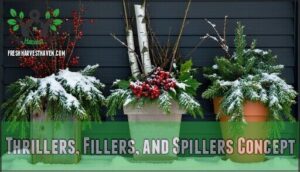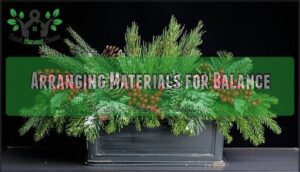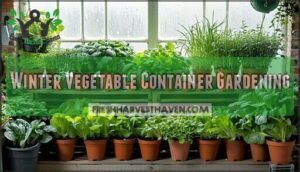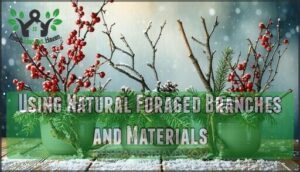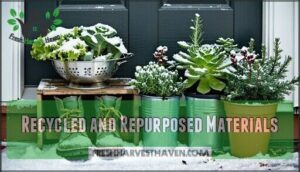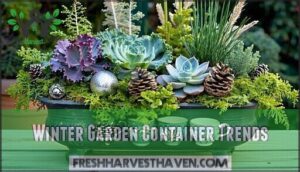This site is supported by our readers. We may earn a commission, at no cost to you, if you purchase through links.
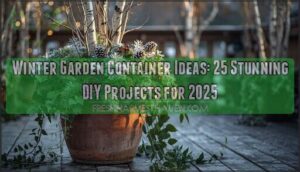
You’ll create stunning displays using evergreen branches, hardy winter vegetables, and decorative elements that handle frost.
Start with the thriller-filler-spiller concept: tall evergreens as thrillers, colorful kale or winter berries as fillers, and trailing ivy as spillers.
Forage free materials like pine boughs, birch branches, and interesting seed pods from your yard.
Add lights for evening sparkle and incorporate unexpected elements like ornamental cabbages or textured bark.
These arrangements last months with minimal care, giving maximum impact during winter’s quieter season.
The secret lies in mixing textures and choosing materials that actually improve with cold weather.
Table Of Contents
- Key Takeaways
- Winter Container Basics
- Designing Winter Containers
- Winter Vegetable Container Gardening
- Creating Winter Container Arrangements
- Winter Garden Container Trends
- Frequently Asked Questions (FAQs)
- How do you decorate a winter container garden?
- How to make a winter container garden look festive?
- Are winter container plants a good idea?
- What are the best plant containers for winter?
- What to put in a winter planter?
- What do you put in a planter for fall and winter?
- What plants to put in pots for winter?
- What crops can you grow in pots in the winter?
- How to prevent winter container soil freezing?
- When to start planning winter container gardens?
- Conclusion
Key Takeaways
- You’ll create stunning winter displays using the thriller-filler-spiller concept with tall evergreens as focal points, colorful kale or winter berries as middle layers, and trailing ivy cascading over edges
- You can forage free materials like pine boughs, birch branches, and seed pods from your yard, then supplement with hardy plants and decorative accessories from local nurseries
- You’ll grow fresh winter vegetables indoors using frost-resistant containers and cold-hardy crops like spinach, lettuce, and kale that thrive in 60-70°F temperatures with proper lighting
- You can transform ordinary containers into eye-catching arrangements by adding battery-powered LED lights, weatherproof ornaments, and unexpected elements like vintage items or metallic accents for unique winter displays
Winter Container Basics
You’ll need three main types of materials to create stunning winter containers that last through the cold months.
Start by collecting weatherproof containers, quality potting soil, and basic tools like pruning shears.
Then gather natural elements from your yard such as evergreen branches, colorful stems, and interesting seed pods.
Before visiting your local nursery to fill any gaps with hardy plants and decorative accessories.
Collecting Materials and Accessories
Building your winter container gardens’ success starts with smart material gathering before the cold hits.
Foraging Materials requires ethical practices and timing. Scout your yard for fallen branches, pinecones, and seed pods during autumn walks. Nature finds like twisted vines and colorful berries create stunning focal points without cost.
Container Selection matters for winter durability. Choose frost-resistant pots that complement your home’s style. Consider browsing options for planters that resist cracking. Grocery store materials offer budget-friendly options – cinnamon sticks, dried oranges, and artificial berries work beautifully.
Essential gathering tips:
- Collect decorative items like ribbon, battery-operated lights, and small ornaments
- Source sustainable materials including burlap, natural twine, and recycled containers
- Gather soil amendments such as perlite for drainage and compost for nutrition
- Stock winter protection supplies like burlap wraps and mulch for plant insulation
Store everything in labeled bins for easy access when inspiration strikes.
Harvesting Branches and Greenery
Winter’s bounty awaits right outside your door. Sharp, clean pruners make all the difference when collecting cedar boughs and holly branches for stunning winter container gardening projects.
| Plant Type | Best Harvesting Time | Preservation Method |
|---|---|---|
| Cedar Boughs | Early morning after frost | Mist daily, store cool |
| Holly Branches | Mid-morning when dry | Submerge stems in water |
| Magnolia Leaves | Late afternoon | Glycerin solution soak |
| Pine Needles | Cool, overcast days | Spray with anti-desiccant |
| Evergreen Foliage | Before 10 AM | Keep in shaded, humid area |
Use 45-degree cuts for healthy regrowth. Never harvest more than one-third from any single plant—this guarantees sustainable sourcing for future winter greenery arrangements. Proper greenery identification helps you select the longest-lasting materials.
Consider using frost resistant containers to prevent cracking during temperature swings. These harvesting techniques and tool selection basics create the foundation for beautiful winter arrangements that’ll last through the season.
Supplementing With Local Nursery Finds
Your neighborhood nursery serves as a treasure trove when foraging falls short. These garden centers stock regional winter varieties specifically chosen for your local plant hardiness zone. Supporting local business means getting expert advice about which winter container plants will thrive in your specific climate.
Local nurseries understand your area’s winter needs better than anyone else.
Most nurseries offer seasonal availability updates and nursery container guarantees. You’ll discover specialized materials that transform ordinary winter garden container ideas into showstoppers. Local nurseries understand your area’s unique challenges and can suggest alternatives when certain plants aren’t available.
- Pre-cut evergreen boughs – Perfect red dogwood stems, pine branches, and yew sprigs when harvesting isn’t possible
- Hardy winter bloomers – Pansies, cyclamen, and ornamental kale that survive your zone’s coldest temperatures
- Specialty containers – Frost-resistant pots designed specifically for winter container garden projects
Designing Winter Containers
Creating stunning winter containers starts with mastering the "thrillers, fillers, and spillers" design principle that transforms ordinary pots into eye-catching displays.
You’ll arrange tall focal plants like evergreens at the center, surround them with medium-height fillers such as colorful kale or berries, then add trailing elements like ivy to cascade over the edges for a balanced and dynamic look.
Thrillers, Fillers, and Spillers Concept
Think of the thriller filler spiller concept as your winter container roadmap.
Thriller Plants like towering birch branches or red dogwood stems create stunning focal points.
Filler Plants such as evergreen boughs and holly berries pack the middle space with texture and color.
Spiller Plants like trailing juniper or cascading ivy soften container edges beautifully.
This seasonal adaptation of the classic thrillerfillerspiller concept guarantees design balance year-round.
Your winter plant combinations will look professionally arranged every time you follow this simple formula.
Arranging Materials for Balance
Mastering visual weight in your winter container arrangements requires a careful eye for balance. Creating stunning displays means distributing elements so nothing feels top-heavy or lopsided. Your goal is achieving harmony between all components.
Design balance starts with understanding how different materials contribute to the overall composition:
- Place heavier visual elements like large evergreens at the base or center
- Use odd numbers when grouping similar items for natural appeal
- Create height variation by positioning tall elements behind shorter ones
- Balance bold colors with neutral tones throughout the arrangement
Color harmony works hand-in-hand with texture contrasts to create depth. Mix smooth holly leaves with spiky pine needles. Combine soft lamb’s ear with rigid ornamental grasses. These layering techniques add dimension while maintaining visual stability.
Step back frequently to assess your work. Rotate the container to check all angles. Adjust placement until the arrangement feels naturally balanced rather than forced.
Incorporating Unexpected Elements
Breaking free from traditional arrangements opens up endless creative possibilities for your winter garden containers.
Repurposed objects like vintage skis or colorful sculptures make striking focal points.
Faux botanicals blend seamlessly with natural greenery while adding year-round durability.
Experiment with unexpected colors like deep purple or bright orange to create conversation starters.
Whimsical decor elements such as miniature figurines or painted stones inject personality.
Mix unusual textures through items like weathered driftwood or metallic accents.
These unexpected elements transform ordinary containers into unique masterpieces that reflect your style.
Winter Vegetable Container Gardening
Growing fresh vegetables indoors during winter months lets you enjoy homegrown produce when outdoor gardens lie dormant.
You’ll need proper containers, quality potting soil, and the right cold-hardy crops to create a thriving indoor winter vegetable garden.
Choosing The Right Containers and Soil
Success hinges on the foundation you choose for your winter vegetable garden. Container materials make the difference between thriving plants and frozen failures. You’ll want frost-resistant options that won’t crack when temperatures drop.
- Container Materials: Choose plastic or ceramic pots that resist winter weather damage
- Container Size: Select 8-12 inch diameter containers for proper root development
- Drainage Solutions: Guarantee multiple drainage holes with saucers to protect indoor surfaces
- Soil Composition: Use quality potting mix enriched with slow-release fertilizer for sustained nutrition
Winter garden planters need good drainage to prevent waterlogged roots. Consider using planters rated frost-resistant for ideal results.
Durable containers paired with well-draining soil create the perfect environment for winter hardiness. Your winter container ideas should prioritize function over form.
Selecting Crops for Indoor Winter Gardening
Choose cold-hardy crops that handle indoor winter conditions. Leafy greens like spinach, lettuce, and kale thrive in 60-70°F temperatures with 10-12 hours of daily light.
Root vegetables need deep containers with loose soil. Asian greens like bok choy yield harvests within 30-40 days. Herbs require only 6-8 hours of light daily for healthy growth.
To maximize yields, consider succession planting seeds every two weeks.
| Crop Category | Best Varieties |
|---|---|
| Leafy Greens | Spinach, Lettuce, Kale |
| Root Vegetables | Radishes, Baby Carrots |
| Herbs | Parsley, Cilantro, Mint |
Caring for Winter Vegetables Indoors
Your winter container vegetables need consistent care to thrive indoors through cold months. Indoor watering schedules shift dramatically—water weekly rather than daily since coldhardy crops use less moisture in cooler conditions.
Here’s your three-step care routine:
- Light requirements: Position containers near south-facing windows for maximum sunlight exposure
- Temperature control: Maintain 45-65°F for ideal growth of brassica family and root vegetables
- Pest control: Check leafy greens weekly for aphids hiding under leaves
Nutrient needs increase during winter growing seasons. Add liquid fertilizer monthly to replenish soil minerals. Keep containers away from cold glass to prevent root shock in your winter container vegetables.
Creating Winter Container Arrangements
Now you can transform simple containers into stunning winter displays that last all season long.
You’ll learn to combine foraged branches with lights and repurposed materials to create beautiful arrangements that withstand cold weather, using techniques that make your displays truly beautiful.
Using Natural Foraged Branches and Materials
Nature’s winter bounty offers endless possibilities for your container displays. Moving from growing vegetables to gathering materials, you’ll discover that Foraged Branch ID becomes your first skill to master.
Winter’s natural materials are your best design partners—learn to spot the treasures hiding in your own backyard.
Here’s your Sustainable Sourcing game plan:
- Identify before you collect – Learn to spot red dogwood stems, pussy willows, and pine species in your area
- Practice ethical harvesting – Take only 10% from any single plant to guarantee Seasonal Availability continues
- Focus on Material Preservation – Air-dry branches and natural elements** like pine cones for weeks before use
- Create Textural Contrast – Mix smooth birch bark with spiky evergreen needles and soft seasonal finds**
Cut branches at 45-degree angles using clean pruners. This promotes healthy regrowth while giving you stunning materials. Your containers will showcase nature’s artistry when you respect the source.
Incorporating Lights and Decorations
The magic begins when you add illumination to your winter container design.
Battery-powered LED light strings offer reliable power sources without messy cords, while solar options provide eco-friendly solutions.
Timer options let you automate your holiday lights display without daily hassle.
For decoration styles, choose weatherproof ornaments that complement your winter garden decor theme.
Metallic baubles catch light beautifully against evergreen backdrops.
Waterproof ribbon creates stunning bows that withstand harsh conditions.
Consider light types carefully – warm white LEDs create cozy ambiance, while multicolored options add festive cheer.
Proper weatherproofing lights guarantees your outdoor decorations survive winter storms, keeping your winter decorations glowing through the season.
You can find a variety of options for festive outdoor lighting online.
Recycled and Repurposed Materials
Beyond lights, upcycled containers offer endless winter garden DIY possibilities that won’t break your budget.
You’ll find treasure in unexpected places when you start viewing household items as potential repurposed vessels. That cracked ceramic pot becomes charming when paired with evergreen sprigs, while old boots make whimsical planters for winter arrangements.
Creative reuse transforms ordinary objects into stunning winter containers:
- Weathered wooden drawers lined with plastic create rustic displays for ornamental kale
- Vintage colanders work perfectly for seasonal arrangements with built-in drainage
- Chipped enamelware and metal tins gain new purpose with festive winter plantings
This approach to sustainable gardening delivers impressive cost savings while reducing waste. Proper drainage prevents waterlogged soil issues that can damage plant roots.
Your winter garden becomes a conversation starter when guests spot these clever material sourcing solutions.
Winter Garden Container Trends
Winter container design trends for 2025 focus on mixing unexpected textures and colors that break traditional holiday rules.
You’ll see more purple accents, metallic elements, and creative repurposing of everyday items alongside classic evergreens, highlighting a trend towards mixing unexpected textures and colors.
Seasonal Color Schemes and Textures
Your color palette choices make all the difference in winter container success. Classic cool combinations like blue spruce with silver fir create serene displays, while warm burgundy dogwood stems paired with ornamental kale add cozy appeal.
Texture contrast works magic – try smooth holly leaves against rough pinecones or soft lamb’s ear with spiky ornamental grasses. Foliage variety keeps things interesting throughout the season.
Seasonal hues from winterberry holly and coral bells provide lasting color when winter blooms fade. Smart winter garden color schemes balance winter garden textures for containers that shine all season long.
Utilizing frost-resistant containers is essential for winter gardening.
Incorporating Unique and Unexpected Elements
Transform your winter garden containers by thinking beyond traditional evergreens. Unexpected Textures like vintage skis, weathered metal sculptures, or glittery ornaments create stunning focal points against snowy backdrops. Unconventional Colors such as deep purple branches or copper-toned elements add dramatic contrast to typical Winter Hues.
- Use Repurposed Finds like old lanterns, driftwood pieces, or ceramic fragments for one-of-a-kind displays
- Position Artificial Elements strategically—faux berries or silk flowers won’t freeze and maintain color all season
- Arrange items in odd numbers (three birch logs, five pinecones) for natural visual balance
These unexpected elements transform ordinary planters into conversation starters that reflect your personal winter garden creativity.
Collaborations and Inspirations for Winter Containers
Through Artistic Partnerships with local Garden Clubs and nurseries, you’ll discover fresh winter container recipes that blend regional traditions.
Designer Spotlights from Online Forums showcase innovative combinations like red-stemmed dogwoods paired with blue conifers.
Community Gardens offer collaborative material sourcing opportunities where neighbors share unique branches and berries.
These Art Influences drive winter garden creativity, with regional winter garden styles varying from snowy Michigan’s hardy evergreens to coastal California’s temperate displays.
The best winter garden inspiration emerges from unexpected collaborative connections that fuel emerging winter garden trends.
Frequently Asked Questions (FAQs)
How do you decorate a winter container garden?
Think of your winter container garden as a symphony—start with a tall evergreen for structure.
Layer in colorful kale and pansies, add trailing ivy, tuck in pinecones, and finish with berry branches for contrast and bird appeal.
These elements combined create a visually appealing and functional garden.
How to make a winter container garden look festive?
Add red berries, colorful stems like dogwood, ornamental kale, and decorative elements such as pinecones or LED lights. Mix evergreens with winter-blooming pansies for festive color contrast.
Are winter container plants a good idea?
You might wonder if winter container plants are worth it.
They’re smart choices.
You get year-round color, structure, and interest.
Evergreens, berries, and hardy blooms can thrive, even in cold months.
Birds and neighbors will notice.
What are the best plant containers for winter?
Choose frost-resistant containers like ceramic, concrete, or fiberglass that won’t crack in freezing temperatures.
Make certain proper drainage holes and consider insulating smaller pots to protect roots from harsh winter conditions, using methods like insulating to safeguard against damage.
What to put in a winter planter?
Think of your planter as a winter stage—set the scene with evergreens for structure.
Add pops of color with berries and pansies, layer in trailing ivy.
Finish with pinecones or twigs for texture and height.
What do you put in a planter for fall and winter?
Fill your fall and winter planter with evergreens like boxwood or juniper for structure.
Add colorful kale, pansies, or coral bells for visual interest.
Include trailing ivy and decorative elements like pinecones or berries to create lasting seasonal beauty.
What plants to put in pots for winter?
Evergreens like boxwood, juniper, and dwarf spruce provide structure.
Add colorful plants such as ornamental kale, coral bells, and pansies.
Include berries from winterberry holly for bird food and visual interest.
What crops can you grow in pots in the winter?
Your winter garden can become an incredible food factory! You can grow leafy greens like kale, spinach, and lettuce in containers during winter.
Cold-hardy herbs such as rosemary, thyme, and sage thrive in pots. Root vegetables like carrots and radishes work well too.
Choose frost-tolerant varieties and provide protection during extreme cold snaps for best results.
How to prevent winter container soil freezing?
Move containers to sheltered spots like garages or wrap them with burlap and bubble wrap. Mulch heavily around plant bases and consider adding windbreaks to protect from harsh elements.
When to start planning winter container gardens?
Contrary to popular belief, you don’t need to wait until autumn’s peak to start planning.
Begin your winter container preparations in late summer or early September.
This timing lets you select healthy plants before nursery stock diminishes and guarantees proper root establishment before harsh weather arrives.
Conclusion
Why settle for bare containers when winter offers unique decorating opportunities?
These winter garden container ideas prove cold weather doesn’t mean boring outdoor spaces. You’ve learned to combine evergreens with hardy vegetables and foraged materials for stunning displays.
Your containers will thrive using the thriller-filler-spiller method while incorporating lights and unexpected textures. Start creating these durable arrangements that actually improve with frost.
Winter gardening becomes rewarding when you embrace the season’s natural beauty and work with cold-weather materials to create stunning displays and durable arrangements that improve with frost.

